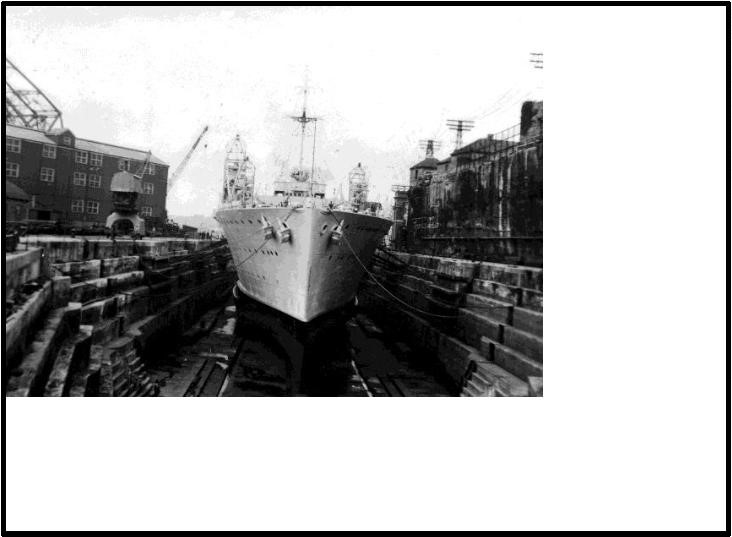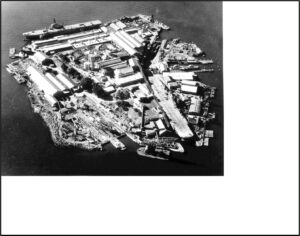| Cockatoo Island has a long association with the RAN. The Island has World HeritageListing and some additional information can be found on our website at https://www.navyhistory.org.au/naval-heritage-sites/cockatoo-island.
This article has been reprinted in the June 2003 edition of the Naval Historical Review(all rights reserved). |
| Cockatoo Island is Sydney Harbour’s largest island. It was named afterflocks of cockatoos that used to congregate in its large red gum trees. It is a sandstonemound rising to about 18 metres above sea level. The island was originally only 32 acres in size,but due to expansion over the years is now 44 acres. Its isolation, deep waters and proximityto other industrial sites since the first European occupation of the island in 1839 has led tothe island having a dynamic and profitable history. It was first used as a penal facility forconvicts transferred from Norfolk Island, then as a dockyard for the construction, repair andrefitting of ships. |
| Governor George Gipps ordered the construction of a prison onCockatoo Island for convictstransferred from Norfolk Island. Their labour was to be used in theconstruction of roads and other public works of the colony. The convicts excavated the sandstonerock and constructed underground silos, which were used to store the colony’s grain. Thesesilos proved invaluable to the population of Sydney, as until then they had been forced to relyupon the irregular shipment of grain from England. Furthermore, the grain was notthreatened by contamination, as the silos were airtight. The sandstone was also used for other construction projects around Sydney, including Circular Quay. |
| 1851
Construction of Fitzroy Dock commenced. Governor Gipps recognisedthe advantage of building a dry dock to enable the repair of visiting ships of the Royal Navy. The dock was builtentirely by convict labour; gangs of convicts in chains chiselling thesandstone by means of achisel and hammer, and took six years to be completed. However,before construction of the dock commenced, the sandstone cliffs that lay across the chosen site had to be removed. Large charges of gunpowder, electrically charged, were used for thispurpose. It was the first time gunpowder was electrically charged in Australia. Accuratecalculations were made to ensure that the sandstone did not simply disintegrate. Indeed, the cliffsfell away in large boulders and the rocks were later used in the construction of various buildings.
|
1871
|
1880
| It became evident that a new dry dock would be needed toaccommodate not only the increasing number but the increasing size of ships arriving atCockatoo Island for repairs. Louis Samuel, a 23 year-old engineer, won the contract to build thedry dock, calledSutherland Dock. Upon its completion it was the largest dry dock inthe world and over the years would require further extensions to accommodate the larger ships of the time. It was completed in 1892. Over the years, activity at the dockyard increased. |
|
|
| 1911 |
| The Royal Australian Navy was created on 10 July.
1913
|
| World War 1
The war years proved to be an arduous time for the dockyard. Repairsand refitting of warships and other vessels such as merchant cruisers and supply ships were in high demand. Around 250 ships were refitted and over 500 vessels were docked atCockatoo Island during the war years. |
The incredible scale of the work undertaken by the dockyard duringthese years can be judged by the following: the ships converted and refitted were arranged to carry in total 4,459 officers
|
| 1920s |
| Whilst the war years had proved very lucrative for the dockyard,construction work diminished in the 1920s to such an extent that it was difficult to run the dockyard ata profit. Attempts were made to get commercial engineering projects for the dockyard tokeep the employees gainfully employed. However, the High Court intervened forconstitutional reasons. It argued that Cockatoo Island, as a government instrumentality, could not compete with private enterprise. These limitations forced the Government of the day toconsider leasing out the dockyard and the plant. In 1923, the management and control ofCockatoo Island, in accordance with the provisions of the Commonwealth Shipping Act1923, was transferred to the Australian Commonwealth Shipping Board. In 1933, CockatooIsland was leased to a newly formed Australian Company: The Cockatoo Docks andEngineering Company Limited. |
| 1929-33 |
| Wing-Commander L.J. Wackett, the celebrated aeronautical engineer and aircraft designer,was behind this unusual activity on Cockatoo Island. Numerous repairs were undertaken on various aircraft, the largest project being the rebuilding of the Southern Cross in which Sir Charles Kingsford Smith had flown the Pacific. Sixty percent of theplane had to be rebuilt after crashing when landing at Mascot on 19 March 1932. |

1933
| During the 1920s shipbuilding had slowed down but picked up againjust before the outbreak of World War II. The Commonwealth ordered the construction of anaval escort vessel HMAS Yarra, followed by HMAS Swan. HMAS Adelaide was modernised, aswas HMAS Australia, which was fitted with additional side armour. The liner Moreton Baywas converted into an armed merchant cruiser, whilst another vessel, the Changte, was converted into a victualling supply ship. |
World War 2
| During the war years dockyard activity at Cockatoo Island was frantic,as the island became the major shipbuilding and dockyard facility for the Pacific region after the fall of Singapore. Hundreds of ships from the RAN and US Navy were docked atCockatoo for refitting and repairs. Wartime dockings totalled 750 vessels, of which 395 weremerchant ships and 350 were naval ships. Work was particularly lengthy because many of theships were seriously damaged and required long periods in dry dock. Eleven RAN shipsrequired repairs including Australia and Hobart. Hobart had suffered extensive damage, notablyto the stern, which was only just hanging on with two propellers and shafting blown off.Australia had suffered considerable damage after being attacked by Kamikaze pilots at thePhilippine landings. |
| 1947 |
| This year marked an important change for Cockatoo Island. Vickers Limited, an engineering company based in London took over the majority of the shares in theCockatoo Docks and |
| Engineering Company Pty Ltd. Vickers had been invaluable toCockatoo during World War II, providing much needed technical aid and training support. |
| 1948 |
| The Daring class destroyer program began. These were based on aBritish design. Voyager and Vampire were built at Cockatoo and completed by the late 50s. Itwas the first time ‘all- welded’ hulls were to be built in Australia. Lack of expertise in this areameant that some of Cockatoo’s technical staff was sent to the United Kingdom to learn thenew techniques required. Cockatoo gained a lot of experience in all-welded ship construction and became a leader in the field, advising shipyards throughout Australia. The increased threats from both air and submarine attack meant the destroyer had greater defence responsibilities. The destroyers provided aircraft carrier escort, and gunfire support to theFleet. Their strong, light construction combined high speed with maximum armament, which included the big guns, lighter anti-aircraft guns, torpedo launchers and anti-submarine mortars. HMAS Voyager sank after a tragic night-time collision with HMAS Melbourne when routine manoeuvres went tragically wrong. Voyager was cut in two, leading to the death of 82officer and sailors. |
| 1950s |
| Construction of Type 12 frigates commenced. HMA Ships Parramattaand Stuart were completed by 1961 and 1963 respectively. Their peacetime roleinvolved patrolling and surveillance; escort duties in ocean and coastal water; command and control of maritime forces and navigation and seamanship training. They wereconsidered to be very sophisticated frigates. Stuart was the first ship to be fitted with theIKARA anti-submarine guided missile. IKARA was an innovative Australian development thatwas later adopted by foreign navies. |
| 1960s |
| Cockatoo Dockyard received very few orders for naval vessels. Indeed, they were verydisappointed when in 1962 the Government ordered two guided-missile destroyers, Hobart and Perth, from the United States. HMAS Brisbane was ordered ayear later. Several ships were constructed at Cockatoo after this time, however the dockyardwas forced to look for outside work. Cockatoo won the contract to build the merchant shipEmpress of Australia. |
1970s
| The service and refit of the Oberon class submarines took place andoperated up to 1991 when the RAN decided to purchase Collins class submarines. Refittingof submarines lasted at least 12 months. In order to free up Sutherland dock, they decided tobuilt a ‘slave dock’ – a type of floating pontoon which was for the exclusive use of the submarines. It proved to be a very useful asset, as once the submarine was loaded onto the slave dock, it could be towed to any berth around the island |

| 1990s |
| The decline in shipping in Australia, and the size of new container ships, meant that Cockatoo Island dockyard was no longer viable. HMAS Success was the last shipto be built before Cockatoo closed in 1992. |
| The Commonwealth regained control of Cockatoo Island in 1992/93.A lot of the plant and machinery was sold and some 40 buildings were demolished. Several wharves were alsoremoved because of their decaying condition. |
2000s
| Cockatoo Island is now administered by the Sydney Harbour FederationTrust. The Sydney Harbour Federation Trust is a self-funding agency created by the AustralianGovernment responsible for vision planning and management of Sydney Harbour sites includingCockatoo Island and Snapper Island in Sydney Harbour, Woolwich Dock and Parklands in Woolwich, HMASPlatypus in Neutral Bay, Georges Heights, Middle Head and Chowder Bay in Mosman, North HeadSanctuary in Manly, Marine Biological Station in Watsons Bay and Macquarie Light station in Vaucluse. The Harbour Trust’s role is to cultivate a long-term vision plan for these sites to ensure they are integratedinto the life of the city and create a lasting legacy for the people of Sydney and Australia |
| Tours of the island are now available via their websitehttp://www.harbourtrust.gov.au/visit/cockatoo- |
|
|
|
|
|
|
|
|
|
|




